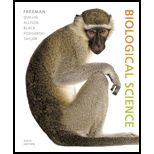
Concept explainers
Name the five main levels of study in ecology and explain why they are said to have a hierarchical relationship.
To review:
The five main levels of the ecological hierarchy and the reason why these levels are said to have a hierarchical relationship.
Introduction:
The five-level ecological hierarchy can be divided according to the increasing complexity: (1) organisms, (2) populations, (3) communities, (4) ecosystems, and (5) the biosphere. These levels are present in a hierarchical pattern because each level is the subset of the level above it.
Explanation of Solution
The biological hierarchy is represented as the hierarchy of the complex biological structures and system. The five levels of the hierarchy are organismal level, population level, community level, ecosystem level, and the global or biosphere level.
1. Organismal ecology: The organismal ecology deals with the study of morphological, physiological, and behavioral adaptations that allow organisms to live in a particular habitat.
2. Population ecology: A population is a group of organisms of the same species that live in the same area at the same time. The population ecology deals with the study of population growth and density changes over time.
3. Community ecology: The term community refers to interaction of populations of different species with each other within a particular area. The community ecology deals with the study of predation, parasitism, and competition, and interactions between coexisting populations.
4. Ecosystem ecology: An ecosystem consists of all the living organisms and nonliving components in a particular area. The ecosystem ecology deals with the study of nutrients and energy and their movement between organisms and surrounding atmosphere.
5. Global ecology: Biosphere is a thin zone extending from 10 km deep down in the sea up to 10 km above into the atmosphere and consists of all terrestrial and aquatic ecosystems.
The biosphere or the globe consists of all the ecosystems on Earth. The ecosystem consists of many communities. The communities consist of many populations. The population consists of many organisms. Each level is the subset of the above level, so they are said to be in hierarchy hierarchical relationship.
Thus, five-level ecological hierarchy is present based on the complexity, so the ecological levels are said to be in a hierarchical relationship.
Want to see more full solutions like this?
Chapter 49 Solutions
Biological Science (6th Edition)
- You intend to insert patched dominant negative DNA into the left half of the neural tube of a chick. 1) Which side of the neural tube would you put the positive electrode to ensure that the DNA ends up on the left side? 2) What would be the internal (within the embryo) control for this experiment? 3) How can you be sure that the electroporation method itself is not impacting the embryo? 4) What would you do to ensure that the electroporation is working? How can you tell?arrow_forwardDescribe a method to document the diffusion path and gradient of Sonic Hedgehog through the chicken embryo. If modifying the protein, what is one thing you have to consider in regards to maintaining the protein’s function?arrow_forwardThe following table is from Kumar et. al. Highly Selective Dopamine D3 Receptor (DR) Antagonists and Partial Agonists Based on Eticlopride and the D3R Crystal Structure: New Leads for Opioid Dependence Treatment. J. Med Chem 2016.arrow_forward
- The following figure is from Caterina et al. The capsaicin receptor: a heat activated ion channel in the pain pathway. Nature, 1997. Black boxes indicate capsaicin, white circles indicate resinferatoxin. You are a chef in a fancy new science-themed restaurant. You have a recipe that calls for 1 teaspoon of resinferatoxin, but you feel uncomfortable serving foods with "toxins" in them. How much capsaicin could you substitute instead?arrow_forwardWhat protein is necessary for packaging acetylcholine into synaptic vesicles?arrow_forward1. Match each vocabulary term to its best descriptor A. affinity B. efficacy C. inert D. mimic E. how drugs move through body F. how drugs bind Kd Bmax Agonist Antagonist Pharmacokinetics Pharmacodynamicsarrow_forward
- 50 mg dose of a drug is given orally to a patient. The bioavailability of the drug is 0.2. What is the volume of distribution of the drug if the plasma concentration is 1 mg/L? Be sure to provide units.arrow_forwardDetermine Kd and Bmax from the following Scatchard plot. Make sure to include units.arrow_forwardChoose a catecholamine neurotransmitter and describe/draw the components of the synapse important for its signaling including synthesis, packaging into vesicles, receptors, transporters/degradative enzymes. Describe 2 drugs that can act on this system.arrow_forward
- The following figure is from Caterina et al. The capsaicin receptor: a heat activated ion channel in the pain pathway. Nature, 1997. Black boxes indicate capsaicin, white circles indicate resinferatoxin. a) Which has a higher potency? b) Which is has a higher efficacy? c) What is the approximate Kd of capsaicin in uM? (you can round to the nearest power of 10)arrow_forwardWhat is the rate-limiting-step for serotonin synthesis?arrow_forwardWhat enzyme is necessary for synthesis of all of the monoamines?arrow_forward
 Biology: The Dynamic Science (MindTap Course List)BiologyISBN:9781305389892Author:Peter J. Russell, Paul E. Hertz, Beverly McMillanPublisher:Cengage Learning
Biology: The Dynamic Science (MindTap Course List)BiologyISBN:9781305389892Author:Peter J. Russell, Paul E. Hertz, Beverly McMillanPublisher:Cengage Learning Biology (MindTap Course List)BiologyISBN:9781337392938Author:Eldra Solomon, Charles Martin, Diana W. Martin, Linda R. BergPublisher:Cengage Learning
Biology (MindTap Course List)BiologyISBN:9781337392938Author:Eldra Solomon, Charles Martin, Diana W. Martin, Linda R. BergPublisher:Cengage Learning Concepts of BiologyBiologyISBN:9781938168116Author:Samantha Fowler, Rebecca Roush, James WisePublisher:OpenStax College
Concepts of BiologyBiologyISBN:9781938168116Author:Samantha Fowler, Rebecca Roush, James WisePublisher:OpenStax College Human Heredity: Principles and Issues (MindTap Co...BiologyISBN:9781305251052Author:Michael CummingsPublisher:Cengage Learning
Human Heredity: Principles and Issues (MindTap Co...BiologyISBN:9781305251052Author:Michael CummingsPublisher:Cengage Learning





